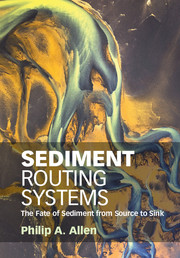Book contents
- Frontmatter
- Contents
- Preface
- Part I A Global View of Sediment Routing Systems
- 1 Sediment Routing Systems: First Concepts
- 2 The Global Character of River Basins
- 3 Global Biogeochemical Cycles
- Part II The Segments of Sediment Routing Systems
- Part III The Functioning of Sediment Routing Systems
- Part IV The Stratigraphic Record of Sediment Routing Systems
- References
- Index
3 - Global Biogeochemical Cycles
from Part I - A Global View of Sediment Routing Systems
Published online by Cambridge University Press: 03 October 2017
- Frontmatter
- Contents
- Preface
- Part I A Global View of Sediment Routing Systems
- 1 Sediment Routing Systems: First Concepts
- 2 The Global Character of River Basins
- 3 Global Biogeochemical Cycles
- Part II The Segments of Sediment Routing Systems
- Part III The Functioning of Sediment Routing Systems
- Part IV The Stratigraphic Record of Sediment Routing Systems
- References
- Index
Summary
Biogeochemistry ofWorld Rivers
The geochemist Abraham Lerman stated (Lerman, 1988) (p.1) that
A global geochemical cycle is a conceptual model of the pathways and flows of individual chemical elements and their compounds in the surface environment of the Earth.
A major goal of global biogeochemistry is to understand the transport processes responsible for these pathways and flows at the present day, to apply this understanding to the past and to predict the future. The most important pathway is riverine transport from source areas on the continental surface to the ocean. Rivers are the primary agents responsible for the fluxes of dissolved solids across the Earth's surface and therefore participate strongly in the functioning of biogeochemical cycles (Garrels and Mackenzie, 1971). The solutes delivered to the world ocean by rivers control its steady-state composition and the nutrient levels necessary for biological productivity.
Although solutes are derived from the weathering of soil and bedrock, they also originate from non-denudational sources such as the atmosphere (precipitation, dust and other aerosols), the mineralisation of organic matter, plant metabolism and man-made pollution. Solutes from non-denudational sources may make up to half of the total dissolved loads of rivers.
The most important denudational source of solutes is from weathering of soils, regolith and bedrock. The different lithologies present in catchments strongly influence their solute loads (Table 3.1). Combining typical water analyses of major rock types with their relative abundance (Table 2.5) allows the solute delivery associated with different rock types to be evaluated. This can be done globally (Meybeck, 1976, 1987; Gaillardet et al., 1999) or for individual catchments (Miller, 2002).
In Meybeck's classic study of the impact of bedrock lithology on river water chemistry (Meybeck, 1986, 1987), water analyses were derived from small, unpolluted catchments in France, constituting the Temperate Stream Model. Water chemistry analyses were based on representative watersheds under different climates with negligible contribution from oceanic salts, where only one bedrock lithology is present and where the stream is perennial. The French watersheds are generally forested and situated in lowland regions (median altitude of 650 m) and are relatively small (median drainage area 7.8 km2).
- Type
- Chapter
- Information
- Sediment Routing SystemsThe Fate of Sediment from Source to Sink, pp. 54 - 80Publisher: Cambridge University PressPrint publication year: 2017



